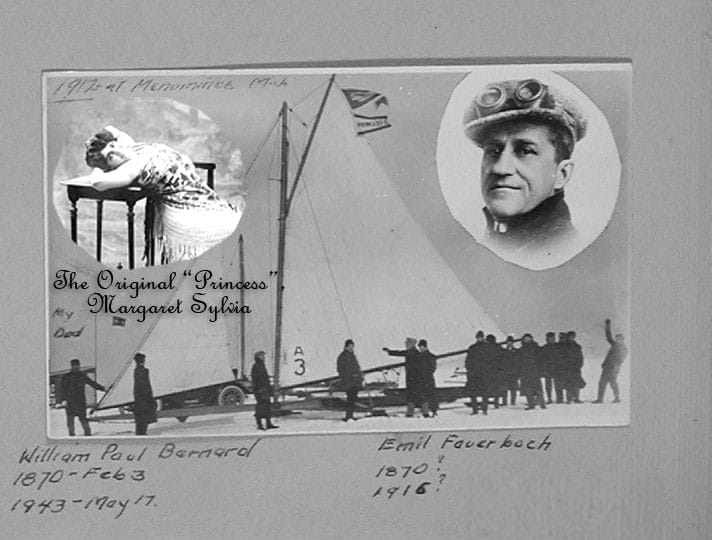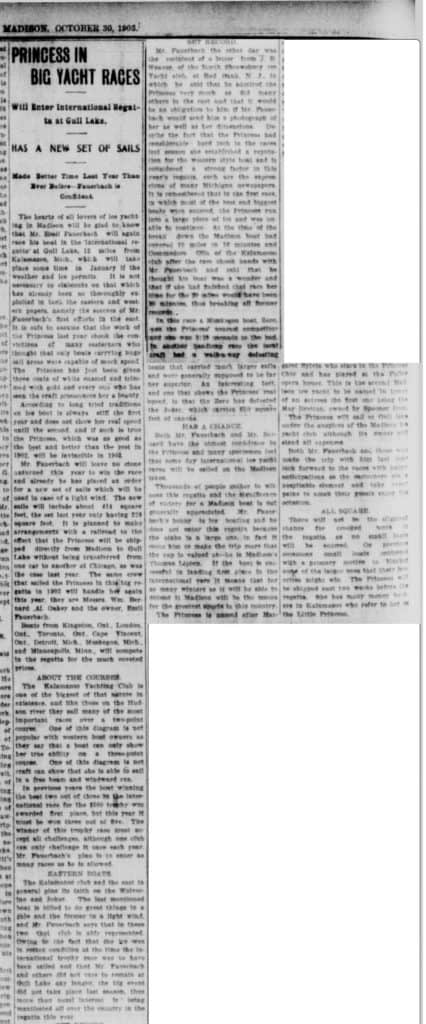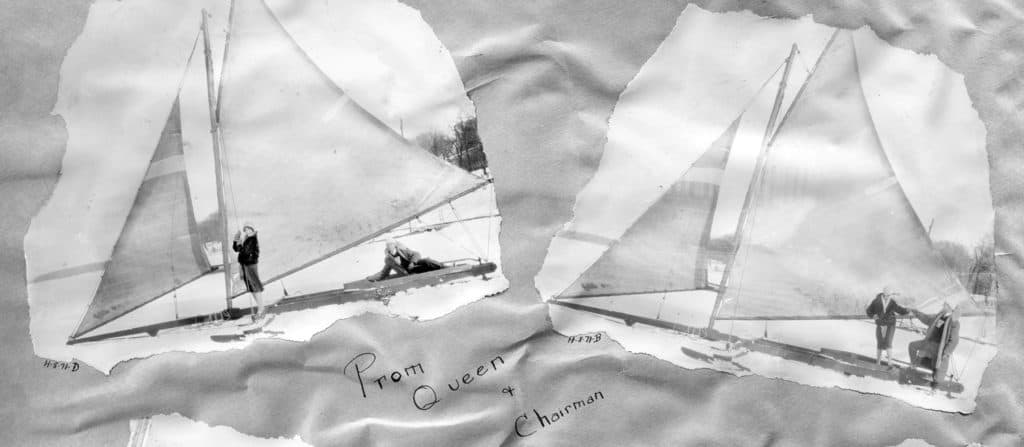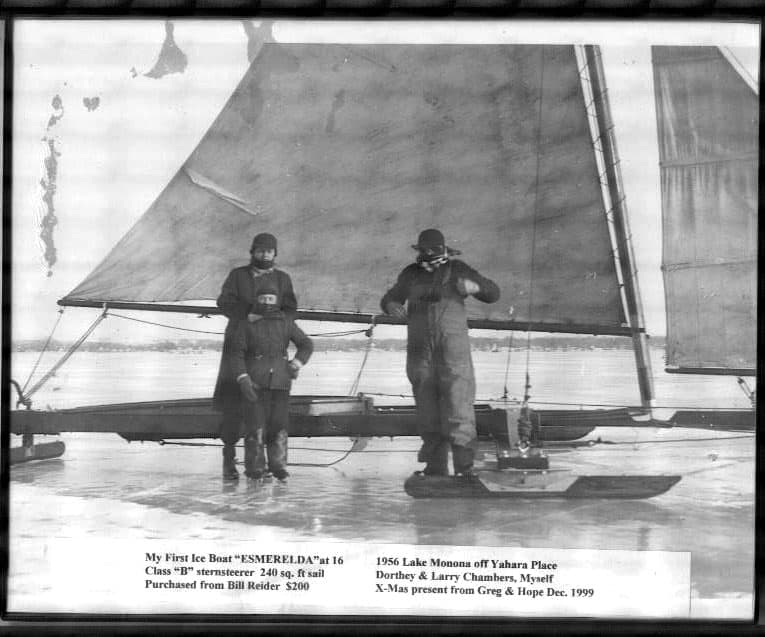by Deb Whitehorse | Apr 20, 2021 | Home Page

PRINCESS II postcard with her namesake added, actress Margaret Sylvia. Postcard from the William & Carl Bernard Collection.
The internet tells me that the ancient Greeks get credit for the tradition of boat-naming, a custom that iceboat builders continued. Growing up iceboating, all Four Lakes Ice Yacht Club classes carried names, even DNs. (In present times, the Estonians seem to be the only DN fleet that consistently attaches a name to a boat.)
 In the late 1800s and early 1900s, Madison’s Fuller opera house hosted the latest touring plays and operas of the day. One actress made such an impression on Emil Fauerbach that he named his grand William Bernard-built ice yachts after her. All three of Fauerbach’s PRINCESS boats owe their name after Margaret Sylvia, who starred in the comic opera Princess Chic.
In the late 1800s and early 1900s, Madison’s Fuller opera house hosted the latest touring plays and operas of the day. One actress made such an impression on Emil Fauerbach that he named his grand William Bernard-built ice yachts after her. All three of Fauerbach’s PRINCESS boats owe their name after Margaret Sylvia, who starred in the comic opera Princess Chic.
We don’t know if Ms. Sylvia ever knew the local fame bestowed upon her or that her namesake won several prestigious regatta titles, including the Hearst. Who knows, maybe one of the reasons William Randolph Hearst, who was well known for his admiration of actresses, donated the Hearst trophy was because Ms. Sylvia told him that a Madisonian had named his iceboat in her honor.
“The PRINCESS is named for Margaret Sylvia who stars in the Princess Chic and has played at the Fuller opera house. This is the second Madison ice yacht to be named in honor of an actress, the first one being the MAY BRETTON, owned by the Spooner Brothers.” Wisconsin State Journal, October 30, 1903

Like this:
Like Loading...
by Deb Whitehorse | Apr 15, 2021 | 2020-2021, Home Page

With the Fat Lady past her sell-by date, the focus is again back in the shop and reviewing iceboating history. Don Sanford sent this photo of an unidentified UW Madison student who was the 1927 Prom Queen posing on an iceboat on Lake Mendota. LIBERTY was a Madison-style iceboat built by 4LIYC member, William Bernard. She won the 1925 Northwest Regatta Class B title and made the local newspapers quite a bit in the late 1920s and early 30s because of her winning record. See the full image here.
Like this:
Like Loading...
by Deb Whitehorse | Mar 17, 2021 | 2020-2021, Home Page

On March 16, 1914, Madisonians Emil Fauerbach and William Bernard brought the Hearst Trophy to Madison, one of the most sought after titles in ice yacht racing.
UPDATE 3-18: The original photo that was posted was incorrect. See more below.
Previous: Throw Back Thursday, Meet Emil Fauerbach
Emil Fauerbach, born 1870, grew up on Lake Monona near his family’s brewery and was obsessed with the beautiful ice yachts he saw flying around the lake, considered the fastest vehicles in the world at the time. One mile away from the brewery on the other side of Madison’s isthmus, William Bernard was born the same year and grew up immersed in his father’s boat livery on Lake Mendota, where he fulfilled his dream of building and designing iceboats.
Fauerbach and Bernard joined forces and chased one of the most prestigious ice yacht racing titles, the Hearst trophy. Newspaper magnate William Randolph Hearst donated a gold-lined silver cup at the behest of the Kalamazoo Ice Yacht Club in Michigan in 1903. Emil’s idea was to challenge for the prestigious Hearst trophy, but in 1904 Emil sailing a Bernard-built boat, returned to Madison from Gull Lake, Michigan, without the title.
Fauerbach and Bernard’s obsession with the Hearst resulted in a new ice yacht explicitly designed to win the coveted cup. Bernard completed Princess II for Fauerbach in January of 1906. Princess II carried 426 square feet of sail, weighed 1500 pounds, and made of the finest white oak and spruce. Between 1904 and 1914, the two determined men traveled six times to Gull Lake, Michigan, trying to win the Hearst. Fauerbach was considered Madison’s “Sir Thomas Lipton,” after the British millionaire yachtsman famous for his five unsuccessful bids to win the America’s Cup.
1914: The Hearst Cup Finally Comes to Madison
PRINCESS II won the Northwest regatta Class A championship in 1914. Shortly after the win, Emil Fauerbach, PRINCESS II, and his crew of Andy Flom, William Bernard, and Hiram Nelson took the train to Michigan.
Fauerbach’s resolve to capture the Hearst for Madison was so great that he put aside his ego and stayed off the boat, turning over control to superior sailor Andy Flom. On March 16, 1914, Emil watched from the finish line as Flom, Nelson, and Bernard finally wrested the Hearst away from the Kalamazoo Ice Yacht Club. They were bringing the elegant trophy to Madison.
 When the news of the victory reached Madison, the citizens were ecstatic. Henry Fauerbach, interviewed at Chicago’s Illinois Athletic Club, declared that his brother’s victory would be a good motivation for ice-yacht racing throughout the whole Northwest. In an understatement, Mendota Yacht Club Commodore Lew Porter told the Wisconsin State Journal, “it is possible that the Mendota Yacht Club will hold some sort of jollification as a result of the victory of the PRINCESS II.” The paper went on to write, “PRINCESS II, sailing the colors of the Mendota Yacht Club, has won for Madison the highest honors in this year’s leading American ice yacht regatta…Madison is particularly gratified at the splendid success of Emil Fauerbach’s iceboat because the game Badger skipper has tried several times to lift the cup.” Fauerbach’s win put Madison on the map as an iceboating community.
When the news of the victory reached Madison, the citizens were ecstatic. Henry Fauerbach, interviewed at Chicago’s Illinois Athletic Club, declared that his brother’s victory would be a good motivation for ice-yacht racing throughout the whole Northwest. In an understatement, Mendota Yacht Club Commodore Lew Porter told the Wisconsin State Journal, “it is possible that the Mendota Yacht Club will hold some sort of jollification as a result of the victory of the PRINCESS II.” The paper went on to write, “PRINCESS II, sailing the colors of the Mendota Yacht Club, has won for Madison the highest honors in this year’s leading American ice yacht regatta…Madison is particularly gratified at the splendid success of Emil Fauerbach’s iceboat because the game Badger skipper has tried several times to lift the cup.” Fauerbach’s win put Madison on the map as an iceboating community.
Sadly, Emil Fauerbach had only a short time to revel in the Hearst trophy’s prestige and honors. Fifteen months after he won the Hearst, Madisonians read the shocking news that their most famous ice yachtsman had passed away. Emil Fauerbach died on May 22, 1915, at 45, from complications of a stomach operation.

Misidentified as “Emil Fauerbach and possibly Andy Flom on PRINCESS I in front of Fauerbach Brewery on Lake Monona, Madison, WI, c.1905. Courtesy of Byron Tetzlaff.” Erich Schloemer pointed out that this boat isn’t a Madison-style boat as all PRINCESS boats were, but instead could be a John Buckstaff-built boat, possibly DEBUTANTE B. Stay tuned for more.
Like this:
Like Loading...
by Deb Whitehorse | Feb 19, 2021 | 2020-2021, Home Page

Photo courtesy Jerry Simon ESMERELDA, a Madison-style Stern-Steerer. Jerry Simon, right, with his aunt and cousin.
Previous: Paul McMillan: My First Iceboat
4LIYC Renegader Jerry Simon received a letter this week from Tim Murray (see below) that made his day.
ESMERELDA was my first iceboat purchased by my parents in 1955 to distract my interests in motorcycles. They bought the boat for $200 from the Bill Rider family, who lived on Lake Monona in Monona, Wisconsin. This picture was the only one I had until the Tim Murray picture arrived.
I am standing next to my aunt Dorothy Chambers, with my cousin Larry both with skates on. The photo was taken off of Yahara Street Park on Lake Monona at the end of Dunning Street in Madison. We sailed out of this park back then and had to carry boats down rock embankment to get on the ice. The iceboaters welcomed us younger guys because lots of labor was needed to take and set up the boats.
Bob Brockel, Harry Fields, and other neighborhood kids were happy to help, hoping for a ride. Phil Sawin would park his “Land Lark” motor home on the grass, which became our headquarters when not on the ice. His white iceboat was called “ICE LARK” and was likely made by the group of early Four Lakes Ice Yacht Club sailors such as Tom Krehl, Paul Krueger, Dave Rosten, Bill Ward, with Bill Mattison and Jack Ripp’s guidance.
As to the name, there were several, depending on the day’s outcome on the ice, but “ESMERELDA” sticks. She was big and slow and would toss you out if you didn’t treat her right—one big momma. We had the most fun when it was windy, sometimes with two or three aboard and one on the end of the plank. The boat slid around because it was impossible to sharpen the runners with my tools. She would spin easily, tossing us out as we would peel off the wind and lose steerage.
Another problem was that the metal bobkin would break off when sailing over rough ice, so I made a wood pattern and cast an aluminum one. Tim Murray’s letter mentions that the boat sat too low on the ice, especially under the mast. Modifying a Carl Bernard creation was not a good idea.
I used her for 2-3 years before buying Jack Ripp’s 2nd Class A Skeeter (a modified Renegade) that I named “PAR-A-DICE.” The Skeeter was faster, lighter, and easier to set up. I’m not sure who bought ESMERELDA from me, but I faintly remember a family off Morrison Street in Madison.
Knowing that Carl Bernard built many Madison-style iceboats, it was likely one of his. Someone said he made nearly 100 over the years in the Bernard Boat Shop, which is now the Hoover Boat House owned by the City of Madison, next to James Madison and Conklin Park.

The Madison-Style Stern Steerer before Jerry Simon owned it. Tim Murray is next to the tiller.
Via Tim Murray:
I came across a slide that my Dad took in the mid-1950s of the iceboat you bought from Bill Rider. My Dad took the photo soon after Bill purchased the boat for his son Gary, my age. The four people on the boat are Dick and Harold George (both deceased), Gary Rider [deceased), and me at the tiller.
I know my Dad took this photo soon after Bill purchased the boat because the boat was already set-up when Bill bought it. The next winter Gary and a few of us set it up once we had good ice. We did not support the middle of the plank correctly when putting it together.
Gary’s idea was to cut some inches off each of the angle planks between the runner plank and the upper plank. I told him not to do that because something just wasn’t right, and we needed to figure it out. Against my advice, Gary proceeded to trim a few inches from each board to fit them in the notches. The modifications caused plank to lose the crown, which meant the boat barely cleared the ice. Rider’s lived on Winnequah Road, so we always had to man-handle the boat when crossing the pressure ridge that ran from roughly Tonyawatha Trail where it meets Winnequah Road to the old ESBMA building on Monona Drive. Dave and John Rosten had to do the same as they lived just a few blocks north of Rider’s.
Like this:
Like Loading...
by Deb Whitehorse | Feb 14, 2021 | Home Page, NIYA

Class E Skeeters line up to race at the 1976 Northwest Regatta on Lake Mendota in Madison, Wisconsin. Photo: Greg Whitehorse
Greg Whitehorse posted this on the 4LIYC Facebook page.
Mid-70’s Northwest Regatta on Lake Mendota.
You are looking at just one side of the starting line, so I’ll guess there are probably 28, maybe more, Class E* Skeeters in this race. M-54 is Gary Sternberg’s “So What,” but I think Vic Whitehorse is at the helm for this race. That would be Dave Nelson’s M-150, “Tuff Ship” lined up next. Racing in the Skeeter class with 30-40 boats on the line was a blast back in the day.
Between the late ’60s and early ’70s, I believe club members helped build ten or more Class E Skeeters in Dave Rosten’s basement. It wasn’t unusual to see Dave, Paul Krueger, Bill Mattison, Jack Ripp, the guy who the boat was being built for, and a host of others all helping out. It was an incredible time.
Skeeter Ice Boat Club’s Sparky Lundberg aced out Paul Krueger for the Class A Skeeter win that year. It may have been the first year for PK’s rear seater.

January 21, 1976, Wisconsin State Journal: Paul Krueger’s first rear-seat Class A Skeeter.
1976 NIYA Regatta Winners:
Class A: No entry
Class B: WINTER BELL, B. Herman
Class C: TWIN BEDS, Bill McCormick
Class D: RED WITCH, Dick Slates
Class E Skeeter: Sparky Lundberg
DN Class: Jane Pegel
DN Class Junior:Mike O’Brien
Renegade Class: Elmer Millenbach RENEGADE III
*The Reason Class A Skeeters are called Class E Skeeters in the Northwest Regatta
The International Skeeter Association designates bow-steering Skeeters Class A as “Single place yachts, or two-place tandem Whose mast, when measured along the mast, does not exceed 28’-6″ from the deck to top of mast, including all mast and deck hardware.” Class A Skeeters carry a maximum of 75 square feet of sail. However, when Class A Skeeters sail in the Northwest regatta, they are listed as “Class E.” (When I was a kid, I thought the E stood for “Experimental.”)
Class A Skeeters turn into Class E because there was already a Class A, B, C, and D in the Northwest, and those designations applied to Stern-Steerers. Skeeters got the left-over E. It reminds us that the Northwest regatta is a Stern-Steerer regatta, organized in 1913 by ice yacht clubs, which only sailed Stern-Steerers at the time. 1936 marks the year that the Northwest recognized Skeeters as an ice yacht class.
Like this:
Like Loading...

 In the late 1800s and early 1900s, Madison’s Fuller opera house hosted the latest touring plays and operas of the day. One actress made such an impression on Emil Fauerbach that he named his grand William Bernard-built ice yachts after her. All three of Fauerbach’s PRINCESS boats owe their name after Margaret Sylvia, who starred in the comic opera Princess Chic.
In the late 1800s and early 1900s, Madison’s Fuller opera house hosted the latest touring plays and operas of the day. One actress made such an impression on Emil Fauerbach that he named his grand William Bernard-built ice yachts after her. All three of Fauerbach’s PRINCESS boats owe their name after Margaret Sylvia, who starred in the comic opera Princess Chic.



 When the news of the victory reached Madison, the citizens were ecstatic. Henry Fauerbach, interviewed at Chicago’s Illinois Athletic Club, declared that his brother’s victory would be a good motivation for ice-yacht racing throughout the whole Northwest. In an understatement, Mendota Yacht Club Commodore Lew Porter told the Wisconsin State Journal, “it is possible that the Mendota Yacht Club will hold some sort of jollification as a result of the victory of the PRINCESS II.” The paper went on to write, “PRINCESS II, sailing the colors of the Mendota Yacht Club, has won for Madison the highest honors in this year’s leading American ice yacht regatta…Madison is particularly gratified at the splendid success of Emil Fauerbach’s iceboat because the game Badger skipper has tried several times to lift the cup.” Fauerbach’s win put Madison on the map as an iceboating community.
When the news of the victory reached Madison, the citizens were ecstatic. Henry Fauerbach, interviewed at Chicago’s Illinois Athletic Club, declared that his brother’s victory would be a good motivation for ice-yacht racing throughout the whole Northwest. In an understatement, Mendota Yacht Club Commodore Lew Porter told the Wisconsin State Journal, “it is possible that the Mendota Yacht Club will hold some sort of jollification as a result of the victory of the PRINCESS II.” The paper went on to write, “PRINCESS II, sailing the colors of the Mendota Yacht Club, has won for Madison the highest honors in this year’s leading American ice yacht regatta…Madison is particularly gratified at the splendid success of Emil Fauerbach’s iceboat because the game Badger skipper has tried several times to lift the cup.” Fauerbach’s win put Madison on the map as an iceboating community.





